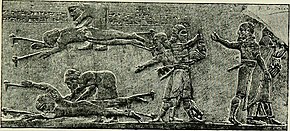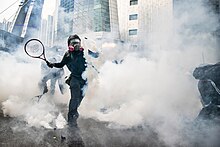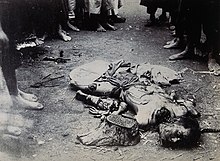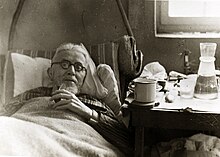Torture

Torture is the deliberate infliction of severe pain or suffering on a person for reasons including punishment, extracting a confession, interrogation for information, intimidating third parties, or entertainment.
Some definitions restrict torture to acts carried out by the state, while others include non-state organizations. Most victims of torture are poor and marginalized people suspected of crimes, although torture against political prisoners or during armed conflict has received disproportionate attention. Judicial corporal punishment and capital punishment are sometimes seen as forms of torture, but this label is internationally controversial. A variety of methods of torture are used, often in combination; the most common form of physical torture is beatings. Beginning in the twentieth century, many torturers have preferred non-scarring or psychological methods to maintain deniability.
Torturers more commonly act out of fear or due to limited resources rather than sadism. Although most torturers are thought to learn about torture techniques informally and rarely receive explicit orders, they are enabled by organizations that facilitate and encourage their behavior. Once a torture program begins, it usually escalates beyond what is intended initially and often leads to involved agencies losing effectiveness. Torture aims to break the victim's will, destroy their agency and personality, and is cited as one of the most damaging experiences that a person can undergo. Many victims suffer both physical damage—chronic pain is particularly common—and mental sequelae. Although torture survivors have some of the highest rates of post-traumatic stress disorder, many are psychologically resilient.
Torture has been carried out since ancient times. However, in the eighteenth and nineteenth centuries, many Western countries abolished the official use of torture in the judicial system, although it continued to be used throughout the world. Public opinion research shows general opposition to torture. It is prohibited under international law for all states under all circumstances and is explicitly forbidden by several treaties. Opposition to torture stimulated the formation of the human rights movement after World War II, and it continues to be an important human rights issue. Although prevention efforts have been of mixed effectiveness, institutional reforms and the elimination of incommunicado detention have had positive effects. Despite its decline, torture is still practiced in or by most countries.
Definitions
[edit]Torture[a] is defined as the deliberate infliction of severe pain or suffering on someone under the control of the perpetrator.[2][3] The treatment must be inflicted for a specific purpose, such as punishment and forcing the victim to confess or provide information.[4][5] The definition put forth by the United Nations Convention against Torture only considers torture carried out by the state.[6][7][8] Most legal systems include agents acting on behalf of the state, and some definitions add non-state armed groups, organized crime, or private individuals working in state-monitored facilities (such as hospitals). The most expansive definitions encompass anyone as a potential perpetrator.[9] Although torture is usually classified as more severe than cruel, inhuman, or degrading treatment (CIDT), the threshold at which treatment can be classified as torture is the most controversial aspect of its definition; the interpretation of torture has broadened over time.[8][6][10] Another approach, preferred by scholars such as Manfred Nowak and Malcolm Evans, distinguishes torture from CIDT by considering only the torturer's purpose, and not the severity.[11][12] Other definitions, such as that in the Inter-American Convention to Prevent and Punish Torture, focus on the torturer's aim "to obliterate the personality of the victim".[13][14]
History
[edit]Pre-abolition
[edit]
Torture was legally and morally acceptable in most ancient, medieval, and early modern societies.[15] There is archaeological evidence of torture in Early Neolithic Europe, about 7,000 years ago.[16] Torture is commonly mentioned in historical sources on Assyria and Achaemenid Persia.[17][18] Societies used torture both as part of the judicial process and as punishment, although some historians make a distinction between torture and painful punishments.[19][20] Historically, torture was seen as a reliable way to elicit the truth, a suitable punishment, and deterrence against future offenses.[21] When torture was legally regulated, there were restrictions on the allowable methods;[21] common methods in Europe included the rack and strappado.[22] In most societies, citizens could be judicially tortured only under exceptional circumstances and for a serious crime such as treason, often only when some evidence already existed. In contrast, non-citizens such as foreigners and slaves were commonly tortured.[23]
Torture was rare in early medieval Europe but became more common between 1200 and 1400.[24][25][26] Because medieval judges used an exceptionally high standard of proof, they would sometimes authorize torture when circumstantial evidence tied a person to a capital crime if there were fewer than the two eyewitnesses required to convict someone in the absence of a confession.[25][26] Torture was still a labor-intensive process reserved for the most severe crimes;[27] most torture victims were men accused of murder, treason, or theft.[28] Medieval ecclesiastical courts and the Inquisition used torture under the same procedural rules as secular courts.[29] The Ottoman Empire and Qajar Iran used torture in cases where circumstantial evidence tied someone to a crime, although Islamic law has traditionally considered evidence obtained under torture to be inadmissible.[30]
Abolition and continued use
[edit]
Torture remained legal in Europe during the seventeenth century, but its practice declined.[31][32] Torture was already of marginal importance to European criminal justice systems by its formal abolition in the 18th and early 19th centuries.[33][34] Theories for why torture was abolished include the rise of Enlightenment ideas about the value of the human person,[35][36] the lowering of the standard of proof in criminal cases, popular views that no longer saw pain as morally redemptive,[31][36] and the expansion of imprisonment as an alternative to executions or painful punishments.[35][37] It is not known if torture also declined in non-Western states or European colonies during the nineteenth century.[38] In China, judicial torture, which had been practiced for more than two millennia,[21] was banned in 1905 along with flogging and lingchi (dismemberment) as a means of execution,[39] although torture in China continued throughout the twentieth and twenty-first centuries. [40]
Torture was widely used by colonial powers to subdue resistance and reached a peak during the anti-colonial wars in the twentieth century.[41][42] An estimated 300,000 people were tortured during the Algerian War of Independence (1954–1962),[43] and the United Kingdom and Portugal also used torture in attempts to retain their respective empires.[44] Independent states in Africa, the Middle East, and Asia often used torture in the twentieth century, but it is unknown whether their use of torture increased or decreased compared to nineteenth-century levels.[41] During the first half of the twentieth century, torture became more prevalent in Europe with the advent of secret police,[45] World War I and World War II, and the rise of communist and fascist states.[15]
Torture was also used by both communist and anti-communist governments during the Cold War in Latin America, with an estimated 100,000 to 150,000 victims of torture by United States–backed regimes.[46][47] The only countries in which torture was rare during the twentieth century were the liberal democracies of the West, but torture was still used there, against ethnic minorities or criminal suspects from marginalized classes, and during overseas wars against foreign populations.[41] After the September 11 attacks, the US government embarked on an overseas torture program as part of its war on terror.[48] It is disputed whether torture increases, decreases, or remains constant.[49]
Prevalence
[edit]
Most countries practice torture, although few acknowledge it.[51][52] The international prohibition of torture has not completely stopped torture; instead, states have changed which techniques are used and denied, covered up, or outsourced torture programs.[53] Measuring the rate at which torture occurs is difficult because it is typically committed in secrecy, and abuses are likelier to come to light in open societies where there is a commitment to protecting human rights.[54] Many torture survivors, especially those from poor or marginalized populations, are unwilling to report.[55][56] Monitoring has focused on police stations and prisons, although torture can also occur in other facilities such as immigration detention and youth detention centers.[57][58] Torture that occurs outside of custody—including extrajudicial punishment, intimidation, and crowd control—has traditionally not been counted, even though some studies have suggested it is more common than torture in places of detention.[59][55][56] There is even less information on the prevalence of torture before the twentieth century.[15] Although it is often assumed that men suffer torture at a higher rate than women, there is a lack of evidence.[60] Some quantitative research has estimated that torture rates are either stagnant or increasing over time, but this may be a measurement effect.[49]
Although liberal democracies are less likely to abuse their citizens, they may practice torture against marginalized citizens and non-citizens to whom they are not democratically accountable.[61][42] Voters may support violence against out-groups seen as threatening; majoritarian institutions are ineffective at preventing torture against minorities or foreigners.[62] Torture is more likely when a society feels threatened because of wars or crises,[61][62] but studies have not found a consistent relationship between the use of torture and terrorist attacks.[63]
Torture is directed against certain segments of the population, who are denied the protection against torture given to others.[64][65][62] Torture of political prisoners and torture during armed conflicts receive more attention compared to torture of the poor or criminal suspects.[66][54] Most victims of torture are suspected of crimes; a disproportionate number of victims are from poor or marginalized communities.[67][54] Groups especially vulnerable to torture include unemployed young men, the urban poor, LGBT people, refugees and migrants, ethnic and racial minorities, indigenous people, and people with disabilities.[68] Relative poverty and the resulting inequality in particular leave poor people vulnerable to torture.[69] Criminalization of the poor, through laws targeting homelessness, sex work, or working in the informal economy, can lead to violent and arbitrary policing.[70] Routine violence against poor and marginalized people is often not seen as torture, and its perpetrators justify the violence as a legitimate policing tactic;[71] victims lack the resources or standing to seek redress.[69]
Perpetrators
[edit]
Since most research has focused on torture victims, less is known about the perpetrators of torture.[72] Many torturers see their actions as serving a higher political or ideological goal that justifies torture as a legitimate means of protecting the state.[73][74][62] Fear is often the motivation for torture, and it is typically not a rational response as it is usually ineffective or even counterproductive at achieving the desired aim.[49] Torture victims are often viewed by the perpetrators as severe threats and enemies of the state.[75] Studies of perpetrators do not support the common assumption that they are psychologically pathological.[49][76] Most perpetrators do not volunteer to be torturers;[49] many have an innate reluctance to employ violence, and rely on coping mechanisms, such as alcohol or drugs.[76] Psychiatrist Pau Pérez-Sales finds that torturers act from a variety of motives such as ideological commitment, personal gain, group belonging, avoiding punishment, or avoiding guilt from previous acts of torture.[77]
Although it is often assumed that torture is ordered from above at the highest levels of government,[78] sociologist Jonathan Luke Austin argues that government authorization is a necessary but not sufficient condition for torture to occur, given that a specific order to torture rarely can be identified.[79] In many cases, a combination of dispositional and situational effects lead a person to become a torturer.[77][80] In most cases of systematic torture, the torturers were desensitized to violence by being exposed to physical or psychological abuse during training[81][82][83] which can be a deliberate tactic to create torturers.[49] Even when not explicitly ordered by the government to torture,[84] perpetrators may feel peer pressure due to competitive masculinity.[85] Elite and specialized police units are especially prone to torturing, perhaps because of their tight-knit nature and insulation from oversight.[84] Although some torturers are formally trained, most are thought to learn about torture techniques informally.[86][49]
Torture can be a side effect of a broken criminal justice system in which underfunding, lack of judicial independence, or corruption undermines effective investigations and fair trials.[87][88] In this context, people who cannot afford bribes are likely to become victims of torture.[89][88] Understaffed or poorly trained police are more likely to resort to torture when interrogating suspects.[90][91] In some countries, such as Kyrgyzstan, suspects are more likely to be tortured at the end of the month because of performance quotas.[90]
The contribution of bureaucracy to torture is under-researched and poorly understood.[49] Torturers rely on both active supporters and those who ignore it.[92] Military, intelligence, psychology, medical, and legal professionals can all be complicit in torture.[74] Incentives can favor the use of torture on an institutional or individual level, and some perpetrators are motivated by the prospect of career advancement.[93][94] Bureaucracy can diffuse responsibility for torture and help perpetrators excuse their actions.[81][95] Maintaining secrecy is often essential to maintaining a torture program, which can be accomplished in ways ranging from direct censorship, denial, or mislabeling torture as something else, to offshoring abuses to outside a state's territory.[96][97] Along with official denials, torture is enabled by moral disengagement from the victims and impunity for the perpetrators.[62] Public demand for decisive action against crime or even support for torture against criminals can facilitate its use.[65]
Once a torture program is begun, it is difficult or impossible to prevent it from escalating to more severe techniques and expanding to larger groups of victims, beyond what is originally intended or desired by decision-makers.[98][99][100] Sociologist Christopher J. Einolf argues that "torture can create a vicious cycle in which a fear of internal enemies leads to torture, torture creates false confessions, and false confessions reinforce torturers' fears, leading to a spiral of paranoia and ever-increasing torture"—similar to a witch hunt.[49] Escalation of torture is especially difficult to contain in counterinsurgency operations.[85] Torture and specific techniques spread between different countries, especially by soldiers returning home from overseas wars, although this process is poorly understood.[101][102]
Purpose
[edit]Punishment
[edit]
Torture for punishment dates back to antiquity and is still employed in the twenty-first century.[19] A common practice in countries with dysfunctional justice systems or overcrowded prisons is for police to apprehend suspects, torture them, and release them without a charge.[103][104] Such torture could be performed in a police station,[105] the victim's home, or a public place.[106] In South Africa, the police have been observed handing suspects over to vigilantes to be tortured.[107] This type of extrajudicial violence is often carried out in public to deter others. It discriminatorily targets minorities and marginalized groups and may be supported by the public, especially if people do not trust the official justice system.[108]
The classification of judicial corporal punishment as torture is internationally controversial, although it is explicitly prohibited under the Geneva Conventions.[109] Some authors, such as John D. Bessler, argue that capital punishment is inherently a form of torture carried out for punishment.[110][111] Executions may be carried out in brutal ways, such as stoning, death by burning, or dismemberment.[112] The psychological harm of capital punishment is sometimes considered a form of psychological torture.[113] Others do not consider corporal punishment with a fixed penalty to be torture, as it does not seek to break the victim's will.[114]
Deterrence
[edit]Torture may also be used indiscriminately to terrorize people other than the direct victim or to deter opposition to the government.[115][116] In the United States, torture was used to deter slaves from escaping or rebelling.[117] Some defenders of judicial torture prior to its abolition argued that it deterred crime; reformers contended that because torture was carried out in secret, it could not be an effective deterrent.[118] In the twentieth century, well-known examples include the Khmer Rouge[115] and anti-communist regimes in Latin America, who tortured and murdered their victims as part of forced disappearance.[119] Authoritarian regimes often resort to indiscriminate repression because they cannot accurately identify potential opponents.[120] Many insurgencies lack the necessary infrastructure for a torture program and instead intimidate by killing.[121] Research has found that state torture can extend the lifespan of terrorist organizations, increase incentives for insurgents to use violence, and radicalize the opposition.[122][49] Another form of torture for deterrence is violence against migrants, as has been reported during pushbacks on the European Union's external borders.[123]
Confession
[edit]Torture has been used throughout history to extract confessions from detainees. In 1764, Italian reformer Cesare Beccaria denounced torture as "a sure way to acquit robust scoundrels and to condemn weak but innocent people".[21][124] Similar doubts about torture's effectiveness had been voiced for centuries previously, including by Aristotle.[125][126] Despite the abolition of judicial torture, it sees continued use to elicit confessions, especially in judicial systems placing a high value on confessions in criminal matters.[127][128] The use of torture to force suspects to confess is facilitated by laws allowing extensive pre-trial detention.[129] Research has found that coercive interrogation is slightly more effective than cognitive interviewing for extracting a confession from a suspect, but presents a higher risk of false confession.[130] Many torture victims will say whatever the torturer wants to hear to end the torture.[131][132] Others who are guilty refuse to confess,[133] especially if they believe it would only bring more torture or punishment.[128] Medieval justice systems attempted to counteract the risk of false confession under torture by requiring confessors to provide falsifiable details about the crime, and only allowing torture if there was already some evidence against the accused.[134][28] In some countries, political opponents are tortured to force them to confess publicly as a form of state propaganda.[127]
Interrogation
[edit]
The use of torture to obtain information during interrogation accounts for a small percentage of worldwide torture cases; its use for obtaining confessions or intimidation is more common.[135] Although interrogational torture has been used in conventional wars, it is even more common in asymmetric war or civil wars.[127] The ticking time bomb scenario is extremely rare, if not impossible,[54][136] but is cited to justify torture for interrogation. Fictional portrayals of torture as an effective interrogational method have fueled misconceptions that justify the use of torture.[137] Experiments comparing torture with other interrogation methods cannot be performed for ethical and practical reasons,[138][139][140] but most scholars of torture are skeptical about its efficacy in obtaining accurate information, although torture sometimes has obtained actionable intelligence.[141][142] Interrogational torture can often shade into confessional torture or simply into entertainment,[143] and some torturers do not distinguish between interrogation and confession.[140]
Methods
[edit]
A wide variety of techniques have been used for torture.[145] Nevertheless, there are limited ways of inflicting pain while minimizing the risk of death.[146][60] Survivors report that the exact method used is not significant.[147] Most forms of torture include both physical and psychological elements[148][149] and multiple methods are typically used on one person.[150][60] Different methods of torture are popular in different countries.[151][60] Low-tech methods are more commonly used than high-tech ones, and attempts to develop scientifically validated torture technology have failed.[152] The prohibition of torture motivated a shift to methods that do not leave marks to aid in deniability and to deprive victims of legal redress.[153][154] As they faced more pressure and scrutiny, democracies led the innovation in clean torture practices in the early twentieth century; such techniques diffused worldwide by the 1960s.[155][21] Patterns of torture differ based on a torturer's time limits—for example, resulting from legal limits on pre-trial detention.[156]
Beatings or blunt trauma are the most common form of physical torture[157][158] reported by about two-thirds of survivors.[158] They may be either unsystematic[159] or focused on a specific part of the body, as in falanga (the soles of the feet), repeated strikes against both ears, or shaking the detainee so that their head moves back and forth.[160] Often, people are suspended in painful positions such as strappado or upside-down hanging in combination with beatings.[161] People may also be subjected to stabbings or puncture wounds, have their nails removed, or body parts amputated.[162] Burns are also common, especially cigarette burns, but other instruments are also employed, including hot metal, hot fluids, the sun, or acid.[163] Forced ingestion of water, food, or other substances, or injections are also used as torture.[164] Electric shocks are often used to torture, especially to avoid other methods that are more likely to leave scars.[165] Asphyxiation, of which waterboarding is a form, inflicts torture on the victim by cutting off their air supply.[162]
Psychological torture includes methods that involve no physical element as well as forcing a person to do something and physical attacks that ultimately target the mind.[148] Death threats, mock execution, or being forced to witness the torture of another person are often reported to be subjectively worse than being physically tortured and are associated with severe sequelae.[166] Other torture techniques include sleep deprivation, overcrowding or solitary confinement, withholding of food or water, sensory deprivation (such as hooding), exposure to extremes of light or noise (e.g., musical torture),[167] humiliation (which can be based on sexuality or the victim's religious or national identity),[168] and the use of animals such as dogs to frighten or injure a prisoner.[169][170] Positional torture works by forcing the person to adopt a stance, putting their weight on a few muscles, causing pain without leaving marks, for example standing or squatting for extended periods.[171] Rape and sexual assault are universal torture methods and frequently instill a permanent sense of shame in the victim and in some cultures, humiliate their family and society.[172][173] Cultural and individual differences affect how the victim perceives different torture methods.[174]
Effects
[edit]
Torture is one of the most devastating experiences that a person can undergo.[175] Torture aims to break the victim's will[176] and destroy the victim's agency and personality.[177] Torture survivor Jean Améry argued that it was "the most horrible event a human being can retain within himself" and that "whoever was tortured, stays tortured".[178][179] Many torture victims, including Améry, later die by suicide.[180] Survivors often experience social and financial problems.[181] Circumstances such as housing insecurity, family separation, and the uncertainty of applying for asylum in a safe country strongly impact survivors' well-being.[182]
Death is not an uncommon outcome of torture.[183] Understanding of the link between specific torture methods and health consequences is lacking.[60] These consequences can include peripheral neuropathy, damage to teeth, rhabdomyolysis from extensive muscle damage,[157] traumatic brain injury,[184] sexually transmitted infection, and pregnancy from rape.[185] Chronic pain and pain-related disability are commonly reported, but there is scant research into this effect or possible treatments.[186] Common psychological problems affecting survivors include traumatic stress, anxiety, depression, and sleep disturbance.[187][181] An average of 40 percent have long-term post-traumatic stress disorder (PTSD), a higher rate than for any other traumatic experience.[175] Not all survivors or rehabilitation experts support using medical categories to define their experience,[188] and many survivors remain psychologically resilient.[189]
Criminal prosecutions for torture are rare[190] and most victims who submit formal complaints are not believed.[191] Despite the efforts for evidence-based evaluation of the scars from torture such as the Istanbul Protocol, most physical examinations are inconclusive.[192] The effects of torture are one of several factors that usually result in inconsistent testimony from survivors, hampering their effort to be believed and secure either refugee status in a foreign country or criminal prosecution of the perpetrators.[193]
Although there is less research on the effects of torture on perpetrators,[194] they can experience moral injury or trauma symptoms similar to the victims, especially when they feel guilty about their actions.[195][196] Torture has corrupting effects on the institutions and societies that perpetrate it. Torturers forget important investigative skills because torture can be an easier way than time-consuming police work to achieve high conviction rates, encouraging the continued and increased use of torture.[197][195][198] Public disapproval of torture can harm the international reputation of countries that use it, strengthen and radicalize violent opposition to those states,[199][200][201] and encourage adversaries to themselves use torture.[202]
Public opinion
[edit]Studies have found that most people around the world oppose the use of torture in general.[203][204] Some hold definite views on torture; for others, torture's acceptability depends on the victim.[205] Support for torture in specific cases is correlated with the belief that torture is effective and used in ticking time bomb cases.[206] Women are more likely to oppose torture than men.[207] Nonreligious people are less likely to support the use of torture than religious people, although for the latter group, increased religiosity increases opposition to torture.[208] The personality traits of right-wing authoritarianism, social dominance orientation, and retributivism are correlated with higher support for torture; embrace of democratic values such as liberty and equality reduces support for torture.[208] Public opinion is most favorable to torture, on average, in countries with low per capita income and high levels of state repression.[203] Public opinion is an important constraint on the use of torture by states.[209]
Prohibition
[edit]

The condemnation of torture as barbaric and uncivilized originated in the debates around its abolition.[210] By the late nineteenth century, countries began to be condemned internationally for the use of torture.[211] The ban on torture became part of the civilizing mission justifying colonial rule on the pretext of ending torture,[212][213] despite the use of torture by colonial rulers themselves.[214] The condemnation was strengthened during the twentieth century in reaction to the use of torture by Nazi Germany and the Soviet Union.[215] Shocked by Nazi atrocities during World War II, the United Nations drew up the 1948 Universal Declaration of Human Rights, which prohibited torture.[216][217] Torture is criticized based on all major ethical frameworks, including deontology, consequentialism, and virtue ethics.[218][219] Some contemporary philosophers argue that torture is never morally acceptable; others propose exceptions to the general rule in real-life equivalents of the ticking time-bomb scenario.[220][221]
Torture stimulated the creation of the human rights movement.[222] In 1969, the Greek case was the first time that an international body—the European Commission on Human Rights—found that a state practiced torture[223] and it, along with Ireland v. United Kingdom, formed much of the basis for the definition of torture in international law.[224] In the early 1970s, Amnesty International launched a global campaign against torture, exposing its widespread use despite international prohibition and eventually leading to the United Nations Convention against Torture (CAT) in 1984.[225] Successful civil society mobilizations against torture can prevent its use by governments that possess both motive and opportunity to use torture.[226] Naming and shaming campaigns against torture have shown mixed results; they can be ineffective and even make things worse.[49]
The prohibition of torture is a peremptory norm (jus cogens) in international law, meaning that it is forbidden for all states under all circumstances.[227][228] Most jurists justify the absolute legal prohibition on torture based on its violation of human dignity.[229] The CAT and its Optional Protocol focus on the prevention of torture, which was already prohibited in international human rights law under other treaties such as the International Covenant on Civil and Political Rights.[230][231] The CAT specifies that torture must be a criminal offense under a country's laws,[58] evidence obtained under torture may not be admitted in court, and deporting a person to another country where they are likely to face torture is forbidden.[228] Even when it is illegal under national law, judges in many countries continue to admit evidence obtained under torture or ill treatment.[232][233] It is disputed whether ratification of the CAT decreases, does not affect, or even increases the rate of torture in a country.[49]
In international humanitarian law, which regulates the conduct of war, torture was first outlawed by the 1863 Lieber Code.[234] Torture was prosecuted during the Nuremberg trials as a crime against humanity;[235] it is recognized by both the 1949 Geneva Conventions and the 1998 Rome Statute of the International Criminal Court as a war crime.[236][237] According to the Rome Statute, torture can also be a crime against humanity if committed as part of a systematic attack on a civilian population.[238] In 1987, Israel became the only country in the world to purportedly legalize torture.[239][240][241]
Prevention
[edit]Torture prevention is complicated both by lack of understanding about why torture occurs and by lack of application of what is known.[49] Torture proliferates in situations of incommunicado detention.[242][243] Because the risk of torture is highest directly after an arrest, procedural safeguards such as immediate access to a lawyer and notifying relatives of an arrest are the most effective ways of prevention.[244] Visits by independent monitoring bodies to detention sites can also help reduce torture.[245] Legal changes that are not implemented in practice have little effect on the incidence of torture.[246] Legal changes can be particularly ineffective in places where the law has limited legitimacy or is routinely ignored.[58]
Sociologically torture operates as a subculture, frustrating prevention efforts because torturers can find a way around rules.[247] Safeguards against torture in detention can be evaded by beating suspects during round-ups or on the way to the police station.[248][249] General training of police to improve their ability to investigate crime has been more effective at reducing torture than specific training focused on human rights.[250][251] Institutional police reforms have been effective when abuse is systematic.[252][253] Political scientist Darius Rejali criticizes torture prevention research for not figuring out "what to do when people are bad; institutions broken, understaffed, and corrupt; and habitual serial violence is routine".[254]

References
[edit]- ^ From Middle Latin tortura: 'pain inflicted by judicial or ecclesiastical authority as a means of persuasion', ultimately from a Latin root meaning 'to twist'.[1]
- ^ Whitney & Smith 1897, p. 6396.
- ^ Nowak 2014, pp. 396–397.
- ^ Carver & Handley 2016, p. 38.
- ^ Nowak 2014, pp. 394–395.
- ^ Pérez-Sales 2016, pp. 96–97.
- ^ a b Carver & Handley 2016, pp. 37–38.
- ^ Nowak 2014, p. 392.
- ^ a b Hajjar 2013, p. 40.
- ^ Pérez-Sales 2016, pp. 279–280.
- ^ Saul & Flanagan 2020, pp. 364–365.
- ^ Carver & Handley 2016, p. 37.
- ^ Nowak 2014, p. 391.
- ^ Pérez-Sales 2016, pp. 3, 281.
- ^ Wisnewski 2010, pp. 73–74.
- ^ a b c Einolf 2007, p. 104.
- ^ Meyer et al. 2015, p. 11217.
- ^ Jacobs, Bruno (16 March 2017). "Torture in the Achaemenid Period". Encyclopedia Iranica. Retrieved 7 March 2022.
- ^ Frahm 2006, p. 81.
- ^ a b Hajjar 2013, p. 14.
- ^ Barnes 2017, pp. 26–27.
- ^ a b c d e Evans 2020, History of Torture.
- ^ Beam 2020, p. 393.
- ^ Einolf 2007, p. 107.
- ^ Beam 2020, p. 392.
- ^ a b Einolf 2007, pp. 107–108.
- ^ a b Hajjar 2013, p. 16.
- ^ Beam 2020, pp. 398, 405.
- ^ a b Beam 2020, p. 394.
- ^ Wisnewski 2010, p. 34.
- ^ Einolf 2007, p. 108.
- ^ a b Einolf 2007, p. 109.
- ^ Beam 2020, p. 400.
- ^ Einolf 2007, pp. 104, 109.
- ^ Beam 2020, p. 404.
- ^ a b Hajjar 2013, p. 19.
- ^ a b Wisnewski 2010, p. 25.
- ^ Beam 2020, pp. 399–400.
- ^ Einolf 2007, p. 111.
- ^ Bourgon 2003, p. 851.
- ^ Pérez-Sales 2016, p. 155.
- ^ a b c Einolf 2007, p. 112.
- ^ a b Hajjar 2013, p. 24.
- ^ Pérez-Sales 2016, pp. 148–149.
- ^ Barnes 2017, p. 94.
- ^ Wisnewski 2010, p. 38.
- ^ Einolf 2007, pp. 111–112.
- ^ Hajjar 2013, pp. 27–28.
- ^ Hajjar 2013, pp. 1–2.
- ^ a b c d e f g h i j k l m Einolf 2023.
- ^ Carver & Handley 2016, p. 39.
- ^ Kelly 2019, p. 2.
- ^ Hajjar 2013, p. 42.
- ^ Barnes 2017, p. 182.
- ^ a b c d Carver & Handley 2016, p. 36.
- ^ a b Kelly et al. 2020, pp. 73, 79.
- ^ a b Jensena et al. 2017, pp. 406–407.
- ^ Rejali 2020, pp. 84–85.
- ^ a b c Kelly et al. 2020, p. 65.
- ^ Kelly 2019, pp. 3–4.
- ^ a b c d e Milewski et al. 2023.
- ^ a b Einolf 2007, p. 106.
- ^ a b c d e Evans 2020, Political and Institutional Influences on the Practice of Torture.
- ^ Rejali 2020, p. 82.
- ^ Wolfendale 2019, p. 89.
- ^ a b Celermajer 2018, pp. 161–162.
- ^ Oette 2021, p. 307.
- ^ Kelly 2019, pp. 5, 7.
- ^ Oette 2021, p. 321.
- ^ a b Kelly et al. 2020, p. 70.
- ^ Oette 2021, pp. 329–330.
- ^ Celermajer 2018, pp. 164–165.
- ^ Austin 2022, p. 19.
- ^ Wisnewski 2010, pp. 192–193.
- ^ a b Wolfendale 2019, p. 92.
- ^ Wisnewski 2010, pp. 194–195.
- ^ a b Austin 2022, pp. 29–31.
- ^ a b Pérez-Sales 2016, p. 106.
- ^ Austin 2022, pp. 22–23.
- ^ Austin 2022, p. 25.
- ^ Austin 2022, p. 23.
- ^ a b Collard 2018, p. 166.
- ^ Wisnewski 2010, pp. 191–192.
- ^ Celermajer 2018, pp. 173–174.
- ^ a b Wisnewski 2010, pp. 193–194.
- ^ a b Rejali 2020, p. 90.
- ^ Austin 2022, pp. 25–27.
- ^ Celermajer 2018, p. 178.
- ^ a b Carver & Handley 2016, p. 633.
- ^ Celermajer 2018, p. 161.
- ^ a b Carver & Handley 2016, p. 79.
- ^ Celermajer 2018, p. 176.
- ^ Huggins 2012, pp. 47, 54.
- ^ Huggins 2012, p. 62.
- ^ Rejali 2020, pp. 78–79, 90.
- ^ Huggins 2012, pp. 61–62.
- ^ Huggins 2012, pp. 57, 59–60.
- ^ Evans 2020, Conclusion.
- ^ Hassner 2020, pp. 18–20.
- ^ Wolfendale 2019, pp. 89–90, 92.
- ^ Rejali 2020, pp. 89–90.
- ^ Collard 2018, pp. 158, 165.
- ^ Rejali 2020, pp. 75, 82–83, 85.
- ^ Oette 2021, p. 331.
- ^ Kelly et al. 2020, p. 73.
- ^ Celermajer 2018, pp. 167–168.
- ^ Jensena et al. 2017, pp. 404, 408.
- ^ Kelly et al. 2020, p. 75.
- ^ Kelly et al. 2020, p. 74.
- ^ Nowak 2014, pp. 408–409.
- ^ Nowak 2014, p. 393.
- ^ Bessler 2018, p. 3.
- ^ Quiroga & Modvig 2020, pp. 414, 422, 427.
- ^ Bessler 2018, p. 33.
- ^ Evans 2020, The Definition of Torture.
- ^ a b Hajjar 2013, p. 23.
- ^ Pérez-Sales 2016, p. 270.
- ^ Young & Kearns 2020, p. 7.
- ^ Barnes 2017, pp. 26, 38, 41.
- ^ Hajjar 2013, p. 28.
- ^ Blakeley 2007, p. 392.
- ^ Rejali 2009, p. 38.
- ^ Hassner 2020, pp. 21–22.
- ^ Guarch-Rubio et al. 2020, pp. 69, 78.
- ^ Wisnewski 2010, p. 26.
- ^ Wisnewski 2010, pp. 26–27.
- ^ Barnes 2017, p. 40.
- ^ a b c Hajjar 2013, p. 22.
- ^ a b Einolf 2022, p. 11.
- ^ Rejali 2009, pp. 50–51.
- ^ Pérez-Sales 2016, p. 327.
- ^ Hassner 2020, p. 16.
- ^ Rejali 2009, pp. 461–462.
- ^ Rejali 2009, p. 362.
- ^ Barnes 2017, p. 28.
- ^ Rejali 2020, p. 92.
- ^ Hajjar 2013, p. 4.
- ^ Rejali 2020, pp. 92–93, 106.
- ^ Houck & Repke 2017, pp. 277–278.
- ^ Hassner 2020, p. 24.
- ^ a b Einolf 2022, p. 2.
- ^ Einolf 2022, p. 3.
- ^ Rejali 2020, p. 71.
- ^ Hassner 2020, pp. 16, 20.
- ^ Rejali 2009, pp. 425, 443.
- ^ Quiroga & Modvig 2020, p. 410.
- ^ Einolf 2007, p. 103.
- ^ Pérez-Sales 2016, p. 110.
- ^ a b Pérez-Sales 2020, p. 432.
- ^ Pérez-Sales 2016, p. 8.
- ^ Rejali 2009, p. 421.
- ^ Rejali 2009, p. 420.
- ^ Rejali 2009, pp. 440–441.
- ^ Rejali 2009, p. 443.
- ^ Pérez-Sales 2016, p. xix.
- ^ Rejali 2020, p. 73.
- ^ Pérez-Sales 2016, pp. 271–272.
- ^ a b Quiroga & Modvig 2020, p. 413.
- ^ a b Milewski et al. 2023, eFigure 3.
- ^ Quiroga & Modvig 2020, p. 411.
- ^ Quiroga & Modvig 2020, pp. 413–414.
- ^ Quiroga & Modvig 2020, pp. 414–415.
- ^ a b Quiroga & Modvig 2020, pp. 418–419.
- ^ Quiroga & Modvig 2020, pp. 421–422.
- ^ Quiroga & Modvig 2020, p. 423.
- ^ Einolf 2007, pp. 103–104.
- ^ Quiroga & Modvig 2020, pp. 426–427.
- ^ Quiroga & Modvig 2020, pp. 424–425.
- ^ Pérez-Sales 2020, p. 114.
- ^ Pérez-Sales 2020, pp. 163, 333.
- ^ Quiroga & Modvig 2020, p. 420.
- ^ Quiroga & Modvig 2020, pp. 415–416.
- ^ Hajjar 2013, p. 52.
- ^ Pérez-Sales 2020, pp. 79, 115, 165.
- ^ Pérez-Sales 2020, pp. 86–88.
- ^ a b Pérez-Sales 2016, p. 274.
- ^ Pérez-Sales 2016, pp. 60–61.
- ^ Wisnewski 2010, p. 73.
- ^ Hajjar 2013, p. 51.
- ^ Shue 2015, p. 120.
- ^ Wisnewski 2010, pp. 121–122.
- ^ a b Hamid et al. 2019, p. 3.
- ^ Williams & Hughes 2020, pp. 133–134, 137.
- ^ Quiroga & Modvig 2020, p. 428.
- ^ Quiroga & Modvig 2020, p. 412.
- ^ Quiroga & Modvig 2020, p. 422.
- ^ Williams & Hughes 2020, pp. 133–134.
- ^ Williams & Hughes 2020, p. 136.
- ^ Pérez-Sales 2016, pp. 135–136.
- ^ Pérez-Sales 2016, p. 130.
- ^ Carver & Handley 2016, pp. 84–86, 88.
- ^ Weishut & Steiner-Birmanns 2024, p. 88.
- ^ Weishut & Steiner-Birmanns 2024, p. 89.
- ^ Weishut & Steiner-Birmanns 2024, p. 94.
- ^ Hajjar 2013, pp. 53–55.
- ^ a b Rejali 2020, pp. 90–91.
- ^ Wisnewski 2010, pp. 195–196.
- ^ Hassner 2020, p. 23.
- ^ Wisnewski 2010, p. 166.
- ^ Saul & Flanagan 2020, p. 370.
- ^ Blakeley 2007, pp. 390–391.
- ^ Hassner 2020, p. 22.
- ^ Hassner 2020, p. 21.
- ^ a b Rejali 2020, p. 81.
- ^ Houck & Repke 2017, p. 279.
- ^ Hatz 2021, pp. 683, 688.
- ^ Houck & Repke 2017, pp. 276–277.
- ^ Rejali 2020, p. 98.
- ^ a b Hatz 2021, p. 688.
- ^ Rejali 2020, p. 82.
- ^ Barnes 2017, pp. 13, 42.
- ^ Barnes 2017, pp. 48–49.
- ^ Kelly et al. 2020, p. 64.
- ^ Barnes 2017, pp. 51–52.
- ^ Barnes 2017, p. 55.
- ^ Barnes 2017, p. 57.
- ^ Wisnewski 2010, pp. 42–43.
- ^ Barnes 2017, pp. 64–65.
- ^ Hassner 2020, p. 29.
- ^ Wisnewski 2010, pp. 68–69.
- ^ Wisnewski 2010, p. 50.
- ^ Shue 2015, pp. 116–117.
- ^ Hajjar 2013, p. 41.
- ^ Barnes 2017, p. 121.
- ^ Lesch 2023, p. 8.
- ^ Barnes 2017, pp. 108–109.
- ^ Collard 2018, p. 162.
- ^ Evans 2020, Introduction.
- ^ a b Saul & Flanagan 2020, p. 356.
- ^ Pérez-Sales 2016, p. 82.
- ^ Carver & Handley 2016, p. 13.
- ^ Hajjar 2013, p. 39.
- ^ Thomson & Bernath 2020, pp. 474–475.
- ^ Carver & Handley 2016, p. 631.
- ^ Nowak 2014, pp. 387, 401.
- ^ Barnes 2017, pp. 60, 70.
- ^ Nowak 2014, p. 398.
- ^ Hajjar 2013, p. 38.
- ^ Nowak 2014, pp. 397–398.
- ^ "Torture by the GSS". B'Tselem. 1999. Archived from the original on 15 November 2002. Retrieved 28 June 2024.
{{cite web}}: CS1 maint: bot: original URL status unknown (link) - ^ "Israel: Torture still used systematically as Israel presents its report to the Committee Against Torture" (PDF). Amnesty International. 15 May 1998. Retrieved 28 June 2024.
- ^ "It's now (even more) official: torture is legal in Israel". OMCT. 21 March 2019. Retrieved 28 June 2024.
- ^ Carver & Handley 2016, pp. 13–14.
- ^ Thomson & Bernath 2020, p. 472.
- ^ Carver & Handley 2016, pp. 67–68.
- ^ Thomson & Bernath 2020, pp. 482–483.
- ^ Carver & Handley 2016, p. 52.
- ^ Rejali 2020, p. 101.
- ^ Carver & Handley 2016, pp. 69–70.
- ^ Kelly 2019, p. 4.
- ^ Thomson & Bernath 2020, p. 488.
- ^ Carver & Handley 2016, pp. 79–80.
- ^ Carver & Handley 2016, p. 80.
- ^ Kelly 2019, p. 8.
- ^ Rejali 2020, p. 102.
Sources
[edit]Books
[edit]- Barnes, Jamal (2017). A Genealogy of the Torture Taboo. Routledge. ISBN 978-1-351-97773-9.
- Carver, Richard; Handley, Lisa (2016). Does Torture Prevention Work?. Liverpool University Press. ISBN 978-1-78138-868-6.
- Celermajer, Danielle (2018). The Prevention of Torture: An Ecological Approach. Cambridge University Press. ISBN 978-1-108-63389-5.
- Collard, Melanie (2018). Torture as State Crime: A Criminological Analysis of the Transnational Institutional Torturer. Routledge. ISBN 978-1-315-45611-9.
- Hajjar, Lisa (2013). Torture: A Sociology of Violence and Human Rights. Routledge. ISBN 978-0-415-51806-2.
- Pérez-Sales, Pau (2016). Psychological Torture: Definition, Evaluation and Measurement. Taylor & Francis. ISBN 978-1-317-20647-7.
- Rejali, Darius (2009). Torture and Democracy. Princeton University Press. ISBN 978-1-4008-3087-9.
- Wisnewski, J. Jeremy (2010). Understanding Torture. Edinburgh University Press. ISBN 978-0-7486-8672-8.
- Whitney, William Dwight; Smith, Benjamin Eli (1897). The Century Dictionary and Cyclopedia: Dictionary. The Century Company. OCLC 233135357.
- Young, Joseph K.; Kearns, Erin M. (2020). Tortured Logic: Why Some Americans Support the Use of Torture in Counterterrorism. Columbia University Press. ISBN 978-0-231-54809-0.
Book chapters
[edit]- Austin, Jonathan Luke (2022). "Why Perpetrators Matter". Contesting Torture: Interdisciplinary Perspectives. Taylor & Francis. pp. 19–37. ISBN 978-1-000-72592-6.
- Beam, Sara (2020). "Violence and Justice in Europe: Punishment, Torture and Execution". The Cambridge World History of Violence: Volume 3: AD 1500–AD 1800. Cambridge University Press. pp. 389–407. ISBN 978-1-107-11911-6.
- Evans, Rebecca (2020). "The Ethics of Torture: Definitions, History, and Institutions". Oxford Research Encyclopedia of International Studies. Oxford University Press. doi:10.1093/acrefore/9780190846626.013.326. ISBN 978-0-19-084662-6.
- Frahm, Eckart (2006). "Images of Assyria in 19th and 20th Century Scholarship". Orientalism, Assyriology and the Bible. Sheffield Phoenix Press. pp. 74–94. ISBN 978-1-905048-37-3.
- Kelly, Tobias; Jensen, Steffen; Andersen, Morten Koch (2020). "Fragility, states and torture". Research Handbook on Torture: Legal and Medical Perspectives on Prohibition and Prevention. Edward Elgar Publishing. pp. 63–79. ISBN 978-1-78811-396-0.
- Nowak, Manfred (2014). "Torture and Other Cruel, Inhuman, or Degrading Treatment or Punishment". The Oxford Handbook of International Law in Armed Conflict. Oxford University Press. pp. 387–409. ISBN 978-0-19-163269-3.
- Pérez-Sales, Pau (2020). "Psychological torture". Research Handbook on Torture: Legal and Medical Perspectives on Prohibition and Prevention. Edward Elgar Publishing. pp. 432–454. ISBN 978-1-78811-396-0.
- Quiroga, José; Modvig, Jens (2020). "Torture methods and their health impact". Research Handbook on Torture: Legal and Medical Perspectives on Prohibition and Prevention. Edward Elgar Publishing. pp. 410–431. ISBN 978-1-78811-396-0.
- Rejali, Darius (2020). "The Field of Torture Today: Ten Years On from Torture and Democracy". Interrogation and Torture: Integrating Efficacy with Law and Morality. Oxford University Press. pp. 71–106. ISBN 978-0-19-009752-3.
- Saul, Ben; Flanagan, Mary (2020). "Torture and counter-terrorism". Research Handbook on International Law and Terrorism. Edward Elgar Publishing. pp. 354–370. ISBN 978-1-78897-222-2.
- Shue, Henry (2015). "Torture". The Routledge Handbook of Global Ethics. Routledge. pp. 113–126. ISBN 978-1-315-74452-0.
- Thomson, Mark; Bernath, Barbara (2020). "Preventing Torture: What Works?". Interrogation and Torture: Integrating Efficacy with Law and Morality. Oxford University Press. pp. 471–492. ISBN 978-0-19-009752-3.
- Wolfendale, Jessica (2019). "The Making of a Torturer". The Routledge International Handbook of Perpetrator Studies. Routledge. pp. 84–94. ISBN 978-1-315-10288-7.
Journal articles
[edit]- Bessler, John D. (2018). "The Abolitionist Movement Comes of Age: From Capital Punishment as Lawful Sanction to a Peremptory, International Law Norm Barring Executions". Montana Law Review. 79: 7–48. ISSN 0026-9972.
- Bourgon, Jérôme (2003). "Abolishing 'Cruel Punishments': A Reappraisal of the Chinese Roots and Long-term Efficiency of the Xinzheng Legal Reforms". Modern Asian Studies. 37 (4): 851–862. doi:10.1017/S0026749X03004050. ISSN 0026-749X.
- Blakeley, Ruth (2007). "Why torture?" (PDF). Review of International Studies. 33 (3): 373–394. doi:10.1017/S0260210507007565.
- Einolf, Christopher J. (2007). "The Fall and Rise of Torture: A Comparative and Historical Analysis". Sociological Theory. 25 (2): 101–121. doi:10.1111/j.1467-9558.2007.00300.x.
- Einolf, Christopher J. (2022). "How Torture Fails: Evidence of Misinformation from Torture-Induced Confessions in Iraq". Journal of Global Security Studies. 7 (1). doi:10.1093/jogss/ogab019.
- Einolf, Christopher J. (2023). "Understanding and Preventing Torture: a Review of the Literature". Human Rights Review. 24 (3): 319–338. doi:10.1007/s12142-023-00696-2. ISSN 1874-6306. S2CID 260663119.
- Guarch-Rubio, Marta; Byrne, Steven; Manzanero, Antonio L. (2020). "Violence and torture against migrants and refugees attempting to reach the European Union through Western Balkans". Torture. 30 (3): 67–83. doi:10.7146/torture.v30i3.120232. ISSN 1997-3322.
- Hamid, Aseel; Patel, Nimisha; Williams, Amanda C. de C. (2019). "Psychological, social, and welfare interventions for torture survivors: A systematic review and meta-analysis of randomised controlled trials". PLOS Medicine. 16 (9): e1002919. doi:10.1371/journal.pmed.1002919. PMC 6759153. PMID 31550249.
- Hassner, Ron E. (2020). "What Do We Know about Interrogational Torture?". International Journal of Intelligence and CounterIntelligence. 33 (1): 4–42. doi:10.1080/08850607.2019.1660951.
- Hatz, Sophia (2021). "What Shapes Public Support for Torture, and Among Whom?". Human Rights Quarterly. 43 (4): 683–698. doi:10.1353/hrq.2021.0055.
- Houck, Shannon C.; Repke, Meredith A. (2017). "When and why we torture: A review of psychology research". Translational Issues in Psychological Science. 3 (3): 272–283. doi:10.1037/tps0000120.
- Huggins, Martha K. (2012). "State Torture: Interviewing Perpetrators, Discovering Facilitators, Theorizing Cross-Nationally - Proposing "Torture 101"". State Crime Journal. 1 (1): 45–69. ISSN 2046-6056. JSTOR 41917770.
- Jensena, Steffen; Kelly, Tobias; Andersen, Morten Koch; Christiansen, Catrine; Sharma, Jeevan Raj (2017). "Torture and Ill-Treatment Under Perceived: Human Rights Documentation and the Poor". Human Rights Quarterly. 39 (2): 393–415. doi:10.1353/hrq.2017.0023. hdl:20.500.11820/f7a9a490-1825-42ab-802e-3b3825c72bb8. ISSN 1085-794X.
- Kelly, Tobias (2019). "The Struggle Against Torture: Challenges, Assumptions and New Directions". Journal of Human Rights Practice. 11 (2): 324–333. doi:10.1093/jhuman/huz019. hdl:20.500.11820/4cc28414-d254-4ab9-829f-b73a2fffd322.
- Lesch, Max (2023). "From Norm Violations to Norm Development: Deviance, International Institutions, and the Torture Prohibition". International Studies Quarterly. 67 (3). doi:10.1093/isq/sqad043.
- Meyer, Christian; Lohr, Christian; Gronenborn, Detlef; Alt, Kurt W. (2015). "The massacre mass grave of Schöneck-Kilianstädten reveals new insights into collective violence in Early Neolithic Central Europe". Proceedings of the National Academy of Sciences. 112 (36): 11217–11222. Bibcode:2015PNAS..11211217M. doi:10.1073/pnas.1504365112. PMC 4568710. PMID 26283359.
- Milewski, Andrew; Weinstein, Eliana; Lurie, Jacob; Lee, Annabel; Taki, Faten; Pilato, Tara; Jedlicka, Caroline; Kaur, Gunisha (2023). "Reported Methods, Distributions, and Frequencies of Torture Globally: A Systematic Review and Meta-Analysis". JAMA Network Open. 6 (10): e2336629. doi:10.1001/jamanetworkopen.2023.36629. PMC 10548313. PMID 37787994.
- Oette, Lutz (2021). "The Prohibition of Torture and Persons Living in Poverty: From the Margins to the Centre". International & Comparative Law Quarterly. 70 (2): 307–341. doi:10.1017/S0020589321000038. ISSN 0020-5893.
- Weishut, Daniel J. N.; Steiner-Birmanns, Bettina (2024). "A Review of Reasons for Inconsistency in Testimonies of Torture Victims". Psychological Injury and Law. 17 (1): 88–98. doi:10.1007/s12207-024-09498-4. ISSN 1938-971X.
- Williams, Amanda C. de C.; Hughes, John (2020). "Improving the assessment and treatment of pain in torture survivors". BJA Education. 20 (4): 133–138. doi:10.1016/j.bjae.2019.12.003. PMC 7807909. PMID 33456942.
